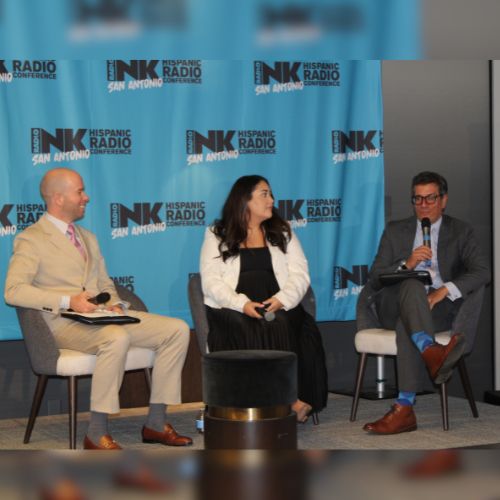From AI to political attention and revenue and audience misconceptions to continued radio legislation, how are Hispanic radio executives tackling today’s toughest issues? Two prominent leaders shared the stage and their thoughts on the industry on Wednesday.
As part of Hispanic Radio Conference 2024‘s Leadership Roundtable, Meruelo Media CEO Otto Padron and Norsan Media CEO Natalia Sanchez Alvarez joined moderator and Radio Ink Online Editor Cameron Coats for a conversation spanning a sweeping array of both high-level and ground-floor issues facing Hispanic broadcasters today.
The discussion kicked off with a reflection on the political advertising revenues which, contrary to the predictions made at last year’s Leadership Roundtable, hadn’t seen the expected upsurge. Despite significant outreach by politicians to Hispanic media outlets, both Padron and Sanchez Alvarez emphasized that the Hispanic vote is increasingly recognized as pivotal by political parties, yet the current advertising spend does not adequately reflect this demographic’s potential impact.
Both did express cautious optimism that the most substantial advertising dollars typically start flowing closer to the election months, noting ongoing preparations to capitalize on this anticipated influx as the election season approaches.
Sanchez Alvarez highlighted Norsan Media’s efforts to mobilize the Hispanic vote through the initiative Norsan Media Contigo. This campaign focuses on educating the Hispanic community on the importance of their vote and facilitating voter registration. Similarly, Padron discussed Meruelo Media’s Tu Vos, Tu Voto, Tu Vida campaign, which aims to debunk myths about voting irrelevance within the Hispanic community and encourage participation in the electoral process. These initiatives underscore the proactive steps taken by their stations to not only engage but also empower their audiences.
The conversation also ventured into the technological advancements impacting the industry, specifically the integration of generative AI. Padron and Sanchez Alvarez shared their perspectives on the use of AI to enhance operational efficiencies without compromising the authentic engagement that radio traditionally offers. While acknowledging the benefits of AI in automating routine tasks and optimizing content distribution, they were adamant about maintaining the human element that is fundamental to radio’s connection with its audience.
Padron took care to also point out the particular disparity that generative AI is commonly English-language-centric, while developers lag behind on Spanish-language AI tools and offerings.
The panelists touched on broader challenges facing the industry, including the need for greater recognition and valuation of Hispanic media by advertisers. They called for a shift in perception among advertisers to view Hispanic media as a vital component of the media landscape, deserving of equitable investment relative to its audience’s size and purchasing power.
The conversation turned to what comes after the AM For Every Vehicle Act, and what radio should focus the legislation’s bipartisan momentum on next. Padron called for lawmakers to take the concept behind the AM act a step further and reengage the FM smartphone chip debate, and Sanchez Alvarez wholeheartedly agreed.
The final questions revolved around misconceptions about Hispanic radio. When asked what the largest misconception about the audience is, Sanchez Alvarez discussed the false notion that Hispanic consumers do not possess substantial disposable income. She also talked about the fallacies of thinking the majority of the Hispanic community is fully acculturated and no longer consumes Spanish-language content.
This is refuted by pointing out that in many markets considered to be emerging, there is a strong preference for Spanish-only media consumption at home. This reality is illustrated by the predominance of Spanish-language programming on the panelists’ radio stations and in their publications, which successfully engage the community.
Padron drew applause and a strong reaction when he discussed the importance of recognizing the unique cultural characteristics of different Hispanic communities, such as Mexican and Cuban, to avoid a one-size-fits-all approach in marketing and content creation. This tailored approach is crucial for the success of campaigns and for connecting genuinely with diverse audiences.
He highlighted the need for parity in how Hispanic media is valued compared to general market media. The call for parity is a call for recognizing the real economic and social influence of Hispanic consumers, which should be reflected in how media campaigns are funded and executed.





